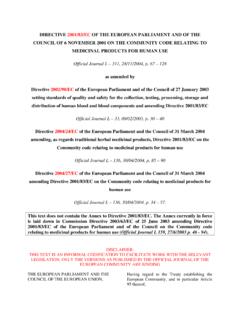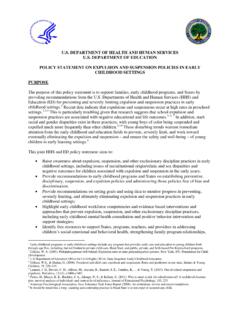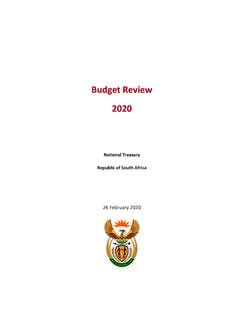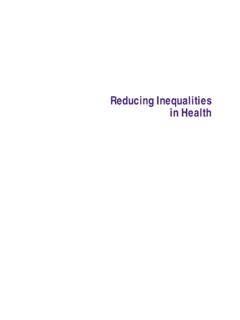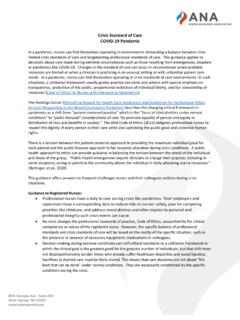Transcription of Fact sheets on sustainable development goals: health ...
1 SDG target : by 2020, halve the number of global deaths and injuries from road traffic accidents. SDG target : by 2030, provide access to safe, affordable, accessible and sustainable transport systems for all, improving road safety, notably by expanding public transport, with special attention to the needs of those in vulnerable situations, women, children, people with disabilities and older people. Fact sheets on sustainable development goals: health targets Road Safety A total of 85 000 people die annually from road traffic injuries in the WHO European Region (1). Addressing the risk of death in road traffic is fundamental to achieve the sustainable development Goals (SDGs), specifically those affecting health security, sustainable cities and reducing inequalities among countries.
2 Action is necessary across all sectors to reduce mortality and morbidity from road crashes. Overview Road transport is an essential means of carrying people and goods but can have high costs in terms of adverse effects on health and welfare. Although the WHO European Region has the lowest road traffic death rates among the WHO regions, these remain a significant public health challenge. Road traffic injuries continue to be the leading cause of death among young people aged 5 29 years (1,2). Sustained political commitment and innovative strategies and technologies have been successfully applied in some of the high-income countries to reduce road traffic injuries and deaths. However, rates of injuries and deaths are increasing in some countries and one third of Member States in the Region do not have a multisectoral national strategy on road safety, suggesting a greater need for policy action.
3 Road safety and SDGs: facts and figures Halve the number of deaths and injuries from road traffic accidents: in 2013, almost 85 000. people died in the WHO European Region from road traffic injuries. Despite an overall increase of 7% in motor vehicles, this represents a decrease of in road traffic deaths in the Region between 2010 and 2013 (1,2). However, if progress continues at this rate, the WHO European Region will fall short of the global SDG target of a 50% reduction in road traffic-related fatalities by 2020 (1,3,4). While the mortality rate from road traffic injuries in the WHO European Region is times lower than the global average ( deaths per 100 000 population relative to globally), great disparity exists within the Region (1). Road traffic fatalities are the tip of the iceberg.
4 For every reported death at least 23 people are injured, with million nonfatal road traffic injuries reported in 2013 requiring hospital admissions, and many more require emergency room attendances (1). Furthermore, road traffic injuries have drastic consequences for the individuals involved and their families: o disability associated with road traffic injuries contributes to a significant public health burden and economic loss in the Region, particularly in countries with low and middle incomes (1);. and o the median estimate of permanent disability from road traffic injuries in the Region is 4% and the societal costs of this are between and of gross national product throughout the Region (1). In 2013, about 40% of people who died as a result of road crashes in the WHO European Region were vulnerable road users such as pedestrians, cyclists or motorcyclists (Fig.)
5 1) (1,4). Legislation is a powerful tool to improve road safety by improving the behaviour of road users. However, there are gaps in both legislation and law enforcement in the WHO European Region (1). For example: o since 2010, six countries have changed laws to bring them into line with best practice on one or several of the five key risk factors speeding, drink-driving, and non-use of motorcycle helmets, seat-belts and child car restraints;. o while some countries in the WHO European Region have legislation in place addressing one or more of the five key risk factors, much more work must be done to enhance their enforcement;. o 20 countries reported a high level of enforcement for seat-belt legislation but only five countries reported this for speed, suggesting the need to extend this good practice; and o only 21 countries in the WHO European Region have national drink-driving laws with a blood alcohol content limit of g/dl as well as lower limits of g/dl for young and novice drivers.
6 Speed contributes to around one third of all fatal road traffic crashes in high-income countries, and up to half in low- and middle-income countries (3,5,6). Lowering average speeds by 5 km/h would cut deaths by 25% in western Europe (3,5,6). Seat-belts reduce the risk of death in a crash by 61% when used correctly (3,5,6). Large disparities exist within the WHO European Region: the death rate from road traffic injuries is times higher in the country with the highest rate than in the country with the lowest rate (Fig. 2) (1,3). Road traffic death rates in countries belonging to the Commonwealth of Independent States are three times higher than that in countries of the European Union (3). 2. Commitment to act The SDGs were adopted in a historic decision by the United Nations General Assembly in September 2015.
7 (7). Two of the targets are specifically related to road safety: SDG 3 target aims to halve the number of global deaths and injuries from road traffic accidents by 2020 and SDG 11 target seeks to provide access to sustainable and safe transport systems. In synergy with the sustainable development Agenda, the WHO. Regional Office for Europe proposed road safety as a priority area in the European policy framework for health and well-being health 2020 (8) and included an additional indicator for age-standardized mortality rate from motor vehicle traffic accidents. After the Decade of action for road safety 2011 2020 was launched on 11 May 2011 (9), the United Nations Road Safety Collaboration developed the Global plan for the decade of action for road safety 2011 2020 (10), which provided a roadmap to stabilize and reduce road traffic fatalities around the world.
8 In line with this Global plan, the following actions are proposed to assist Member States of the WHO European Region to achieve greater safety on their roads (1,3,11): national road safety strategies that include targets to reduce mortality and severe injuries from crashes;. improved injury surveillance systems to enhance data collection and to monitor progress towards the targets;. enactment of laws based on best practice to modify road user behaviour;. enforcement of existing laws governing road safety;. social marketing campaigns to increase the adherence to and acceptance of laws by the public;. the implementation of measures to protect vulnerable road users and to promote physically active transport (Box 1) such as walking and cycling; and investment in public transport and other sustainable forms of transport.
9 Box 1. Leaving no one behind . Protecting vulnerable groups: the risk of dying from road traffic crashes is higher among children, young men, the elderly and populations living in countries in the eastern part of the Region and in low- and middle- income countries (1). For example, countries belonging to the Commonwealth of Independent States have a road traffic mortality rate that is three times higher than that of the European Union (1). Even in high-income countries in Europe, children of deprived families are at greater risk than the children from wealthier families. Some of the risk factors that have been observed in deprived populations are unsafe vehicles, less access to safety equipment and emergency trauma services, and exposure to hazardous traffic situations in unsafe environments (2).
10 The policy measures that are most efficient in reducing death rates among vulnerable groups promote better enactment and enforcement of legislation on road safety, including laws on vehicle speed, drink-driving and the use of child car restraints, seat-belts and motorcycle helmets (2). Through the World health Assembly resolution WHA adopted in May 2016 (12), WHO committed to work with other United Nations organizations to assist the interested countries to develop global performance targets on key risk factors and service delivery mechanisms to reduce road traffic fatalities and injuries (13). In the context of the WHO European Region, the European Union's road safety policy framework 2011 2020. also has a target of 50% reduction in fatalities (11).










